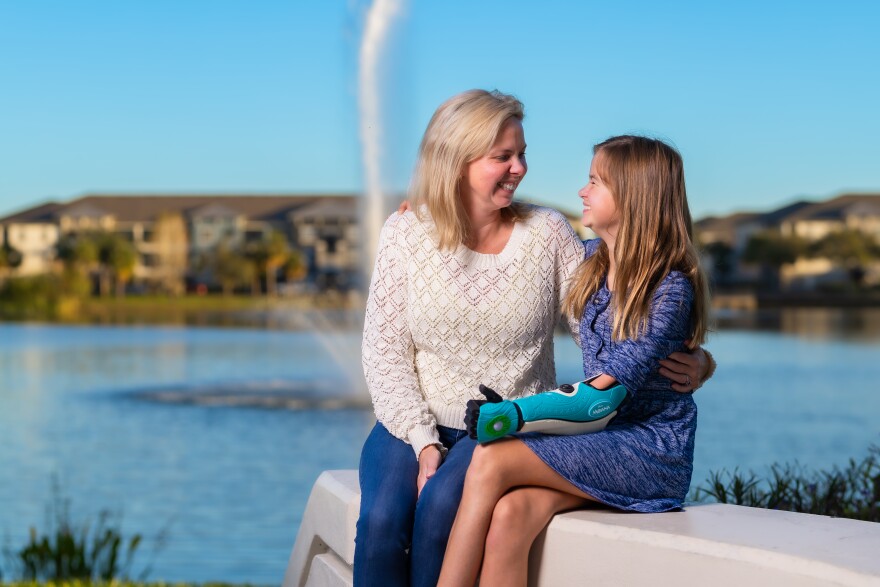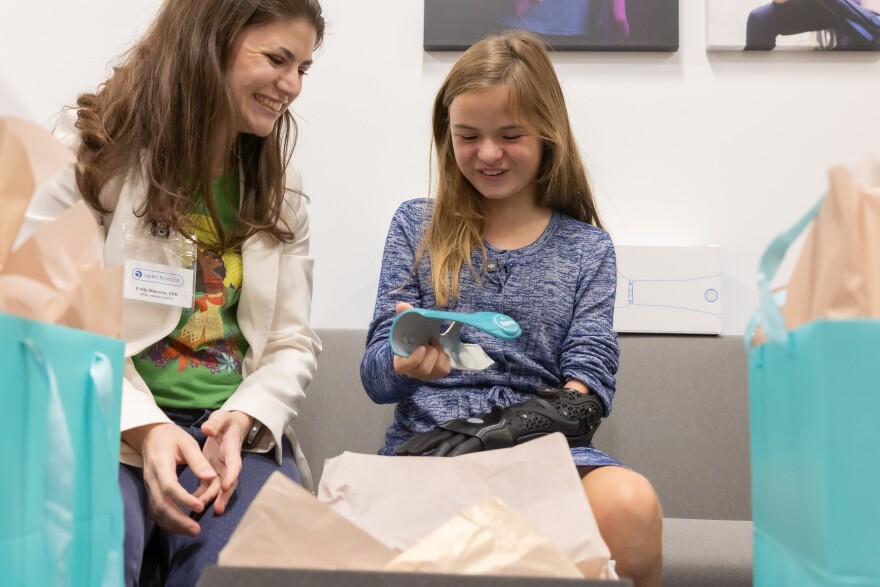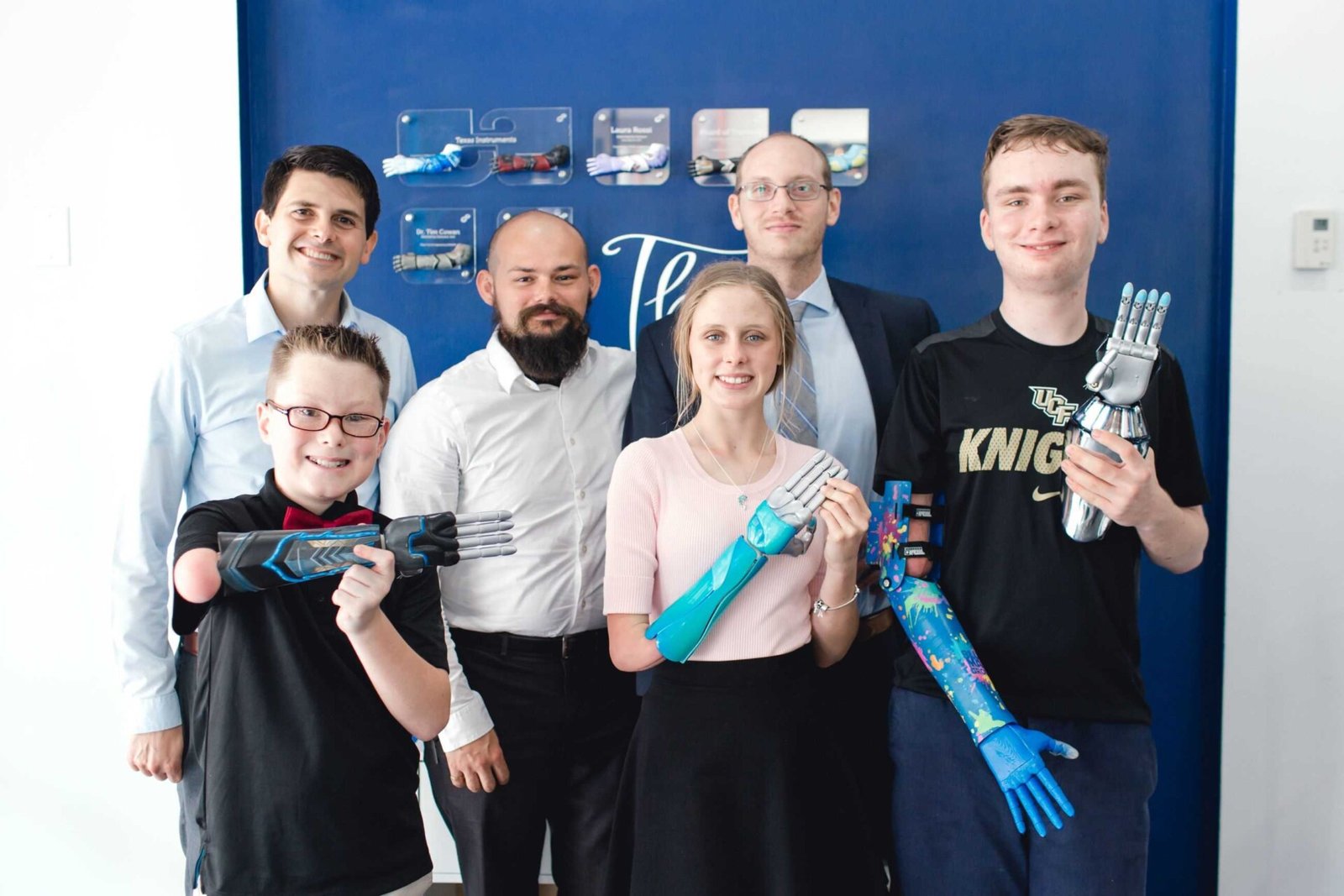Bionic arms for kids have a come long way from where they started 10 years ago in Central Florida. They couldn’t hold much. They were costly to make and replace for growing kids. And they didn’t have much personality.
However, the advent of 3D printing has led to a rapid development in pediatric prosthetics today, which are stronger and sometimes made to resemble characters in popular sci-fi and fantasy stories.
Ten years ago, a small group of University of Central Florida engineers answered the call of a mother seeking a 3D-printed bionic arm for her 6-year-old son.
“This was just a side project with a handful of us trying to figure out how we could help a family, a local family, help one person trying to put our academics into use,” said Albert Manero, the now president of Limbitless Solutions.

The group succeeded in creating the first “3D-printed electromyographic bionic arm for a child in the U.S.” It was the first of the many great strides Limbitless would make over the next 10 years – a microcosm of the overall growth of bionic arms.
Growing from a team of 15, the lab now has 57 undergrad and graduate students, as well as five full-time staffers who work out of Limbitless headquarters located near UCF. The team is made up of a wide variety of specialties including students who create videogame software, which is used to develop fun ways to train children on how to use their new arms in easy-to-digest ways.
The game, “Quantum’s Pursuit,” is a platform shooter that uses the same kind of sensor used in prosthetics. Kids flex their muscles to fire projectiles and move the character through the level.
Wrapping up its 10th year of innovating new ways to arm kids, Limbitless has worked with 60 families, giving children arms, and advancing the technology along the way.
Arming Children
Congenital limb deficiencies are rare. About four out of every 10,000 are born specifically with an upper arm difference, according to the Centers for Disease Control and Prevention. In Florida, 350 babies were born with a limb difference between 2016 and 2020, the most recent data available from the Department of Health. Twenty-three were born in Orange County.
Limbitless works with kids all over the state and country through clinical trials, donating arms, and then tracking data from the patients they later use to better the prosthetic.
One of those kids was Eloise Bayliss, a 12-year-old girl born with one hand. She plays soccer and five instruments, and she loves to fish.

“I’m one of those outdoor kids. I’m not one of those who like to stay inside all day long, but I mean, I love playing Nerf guns with my friend next door, and I’ll draw. I love playing video games too…” Bayliss said.
Growing up she’s tried a lot of different prosthetics that she says all lacked in usefulness.
“We’d tell (engineers) she needs a hand to do this, or she wants an attachment for her bike and they were adult-sized things,” said her mother, Elizabeth Bayliss. “People didn’t know the skill of making pediatric prosthetics, yet. And then they weren’t functional. They didn’t do anything.”
The Bayliss’ journey to find an arm isn’t just for practical use, but also to benefit her social and mental health. At school, kids would point out Eloise’s limb difference and bully her over it.
“It’s been terrible,” Eloise said.
It’s easier when she has a bionic arm in class. The questions shift from “What happened to you?” to a more fascinated “What is that?”
“It’s made such a big difference,” Eloise said.
Elizabeth said that Eloise had been involved with a Limbitless clinical trial for three years.
“They were amazing people, and the technology, is always getting better,” she said.
A little over a year ago, the clinical trial ended, and Eloise returned her arm. However, three months ago, Eloise began working with another bionic arm company, Open Bionics – a company based in the U.K. that has a clinic in Orlando and is also celebrating 10 years of operations.
The arm can lift 30 pounds and has been a big hit with Eloise, who can play piano and ride her bike with the arm, but one of her favorite things to do is prank her friends by holding their hands and trapping them when she grips down.

“They cannot get out. Sometimes it’ll pinch them too,” she giggled.
Although, she hasn’t tried playing video games with it, yet. She’s nervous.
“How do you even play games with two hands?” she asked when considering the idea.
Recently, the company, in partnership with Disney, gifted Eloise turquoise attachments to personalize her arm in the style of Disney’s Moana 2 – complete with the Te Fiti’s heart stone on the back of her hand.
“This is so cool,” she exclaimed upon opening her gift.
Giving arms some flare
Personalizing arms has been one of the important developments of bionic arms in the last 10 years.
“We’re working on some new cosmetic components with a few new partners as we try to get the opportunity to create even more expressive designs,” Manero said.
In its research, Limbitless found that it is just as important for the arm to be functional as it is for it to be an extension of the user’s personality.

The outlet of expression has helped eliminate some stigma surrounding bionic arms. As a result, Limbitless has invested in different painting techniques to craft brighter colors and create more exciting designs, thanks to its creative partners.
The organization also teamed up with Halo Studios and Riot Games to design arms inspired by characters in Halo and League of Legends.
“That’s always our hope is to find great partners who want to be able to use their storytelling abilities so that kids can identify and relate to those,” Manero said.
The 3D Printed renaissance and beyond
When 3D printing emerged as an option for prosthetics it didn’t work well for adults. The material was light and broke easily, said Dan Ferris, a professor of biomechanics at the University of Florida.
“Then people realized that the level of strength that you could get out of the 3D prosthetics might actually work for kids,” Ferris said. “As you go smaller, it turns out all materials become stronger relative to their weight.”
3D printing solved another issue in the pediatric prosthetic community as well – keeping up with the growth of a child. Machining prosthetic parts is costly and making new parts for a growing child wasn’t practical.

“3D printing answers that issue, because you can just quickly and easily replace parts to change the size without having to totally redesign the whole package,” Ferris said.
The overall ease 3D printing yielded to building arms for children led to college clubs and organizations for engineering students springing up all over North America, Ferris said.
“The initial couple of generations were not ideal,” he said. “Over time, more advanced methods have come into play, where research labs at universities have got involved, and they’ve dedicated grad students and faculty to try to refine the designs.”
At Limbitless, the team moved into its new headquarters in 2021, which houses its 60-plus staffers all working on new ways to push the tech further. Some students are working with the technology used to move an arm and expanding it to ALS patients’ wheelchairs; improving their mobility.

Others are combining 3D printing with the much more durable material and printing process of injection molding.
“Fingers used to be too brittle and too fragile, but with our new injection molding machine, that’s no longer the problem,” Manero said.
Currently, Limbitless is partnered with Orlando Health and will be hosting clinical trials, which will allow the group to arm 20 more children per trial, giving kids hands and giving Limbitless data on how to improve them.
“It’s been really unbelievable to watch the program grow from that kitchen table side project into what it is today as a thriving research facility with so many students pouring in their time, and then our staff and our affiliated faculty,” Manero said.
The growth of Limbitless and the bionic prosthetic community as a whole is accelerating, Ferris said, which thrills him.
“We’re at that cusp of an exponential relationship where everything is coming together and converging to make the technologies and the science and the engineering better at a rate which we progressed in a year, what usually took five years of Advances,” he said. “I really love the fact that I know 10 years from now, my mind is going to be blown as to what we can achieve.”
Source: Central Florida Public Media
About Cenfluence:
Cenfluence is a cluster-focused organization that fosters collaboration, innovation, and growth for companies within high-tech sectors, including life sciences, energy+environmental,gaming e-sports+entertainment, learning sciences +human performance and semi-conductors. By connecting members to resources, partnerships, and opportunities, Cenfluence accelerates business development and market expansion while promoting regional economic growth. With a strong commitment to driving innovation, Cenfluence helps its members thrive within a supportive and dynamic ecosystem.
About Limbitless Solutions:
Limbitless Solutions is a nonprofit organization based in Orlando, Florida, and a proud member of the Cenfluence Life Sciences Cluster. The organization empowers children and adults with limb differences by developing innovative, personalized bionic prosthetics. Since its founding, Limbitless has combined advanced engineering, artistic design, and community collaboration to create affordable, life-changing prosthetic solutions while promoting accessibility and inclusion in the medical technology space.

